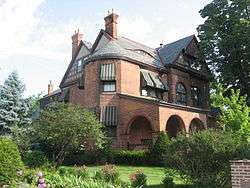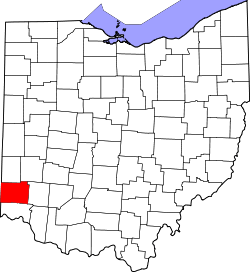John B. Tytus House
|
John B. Tytus House | |
 Front and southern side of the house | |
  | |
| Location | 300 South Main Street, Middletown, Ohio, United States |
|---|---|
| Coordinates | 39°30′46.4″N 84°24′32″W / 39.512889°N 84.40889°WCoordinates: 39°30′46.4″N 84°24′32″W / 39.512889°N 84.40889°W |
| Area | 1 acre (0.40 ha) |
| Architectural style | Romanesque and Tudorbethan architecture |
| Part of | South Main Street District (#78002015) |
| NRHP reference # | 75001335 |
| Significant dates | |
| Added to NRHP | May 27, 1975[1] |
| Designated NHL | May 11, 1976[2] |
| Designated CP | March 21, 1978 |
The John B. Tytus House is a historic house at 300 South Main Street in Middletown, Ohio, United States. Built in 1868, it was the home of John Butler Tytus (1875-1944), who invented a practical hot wide-strip continuous steel-rolling process that transformed the American steelmaking industry. The house was designated a National Historic Landmark in 1976.[2][3]
Description and history
The John B. Tytus House is located in Middletown's South Main Street District, on the west side of South Main Street between Yankee Road and 4th Avenue. It is a three-story masonry structure, built out of red brick. It is L-shaped, with a stylistically eclectic set of architectural features that includes rounded arches in the Romanesque style, half-timbered gable ends in the Tudor Revival style, and an eyebrow dormer. The interior is richly decorated with carved woodwork, and has an original chandelier in the dining room.[3]
The house was built in 1868 by John Butler Tytus Sr., owner of a local papermill, and was the lifelong home of his son, John Butler Tytus; it remained in the Tytus family until 1972. The younger Tytus was educated at Yale University in the humanities before entering his father's business. After his father died, he eventually landed a job at a steel factory owned by Armco, where he developed skills as an engineer and learned the manufacturing process well. Observing that efficiencies of manufacturing could be realized by being able to continuous feed hot steel through a rolling process, he set about to create such a process in 1921. By 1924 his process was sufficiently developed that the company built a new plant implementing it. The plant was an immediate success, and the process was soon widely adopted by other steelmakers. Tytus's process made possible the rolling of steel in sizes and quantities significantly larger than previous labor-intensive processes, at a significantly higher rate of production.[3]
See also
References
- ↑ National Park Service (2007-06-30). "National Register Information System". National Register of Historic Places. National Park Service.
- 1 2 "John B. Tytus House". National Historic Landmark summary listing. National Park Service. Archived from the original on 2011-06-06. Retrieved 2008-02-12.
- 1 2 3 James Sheire (January 1976), National Register of Historic Places Inventory-Nomination: John B. Tytus House (pdf), National Park Service and Accompanying 3 photos, exterior, from 1974 (32 KB)
